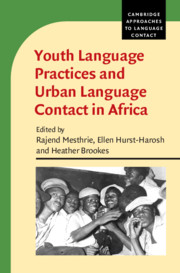Book contents
- Youth Language Practices and Urban Language Contact in Africa
- Cambridge Approaches to Language Contact
- Youth Language Practices and Urban Language Contact in Africa
- Copyright page
- Contents
- Figures
- Tables
- Contributors
- Series Editor’s Foreword
- Preface
- Abbreviations
- Introduction
- 1 Language Contact and Structure in Urban IsiXhosa and Associated Youth Languages
- 2 Not ‘Deep’ but Still IsiXhosa:
- 3 Rethinking Youth Language Practices in South Africa:
- 4 Tsotsitaals, Urban Vernaculars and Contact Linguistics
- 5 Grammatical Hybridity in Camfranglais?
- 6 Sheng and Engsh in Kenya’s Public Spaces and Media
- 7 Exploring Hybridity in Ivorian French and Nouchi
- 8 Authenticity and the Object of Analysis:
- Index
- References
8 - Authenticity and the Object of Analysis:
Methods of Youth Language Data Collection
Published online by Cambridge University Press: 20 August 2021
- Youth Language Practices and Urban Language Contact in Africa
- Cambridge Approaches to Language Contact
- Youth Language Practices and Urban Language Contact in Africa
- Copyright page
- Contents
- Figures
- Tables
- Contributors
- Series Editor’s Foreword
- Preface
- Abbreviations
- Introduction
- 1 Language Contact and Structure in Urban IsiXhosa and Associated Youth Languages
- 2 Not ‘Deep’ but Still IsiXhosa:
- 3 Rethinking Youth Language Practices in South Africa:
- 4 Tsotsitaals, Urban Vernaculars and Contact Linguistics
- 5 Grammatical Hybridity in Camfranglais?
- 6 Sheng and Engsh in Kenya’s Public Spaces and Media
- 7 Exploring Hybridity in Ivorian French and Nouchi
- 8 Authenticity and the Object of Analysis:
- Index
- References
Summary
Researchers in the field of youth language in Africa have often been less than explicit about their sources of data and methods of collection. In order to provide recommendations for future research, this chapter reflects on the preceding chapters and highlights some considerations regarding different methods of data collection and different types of data on youth language practices. We consider naturalistic data and authenticity in youth language data. We present examples of data outcomes from a South African project that captured data on Tsotsitaal, and we also consider the methods presented in the chapters in this book in order to further illustrate the wide range of data outcomes in youth language research. The chapter makes the argument that the most important move is to define the object of analysis – and that it cannot be simplistically described as 'youth language'.
- Type
- Chapter
- Information
- Youth Language Practices and Urban Language Contact in Africa , pp. 182 - 200Publisher: Cambridge University PressPrint publication year: 2021

